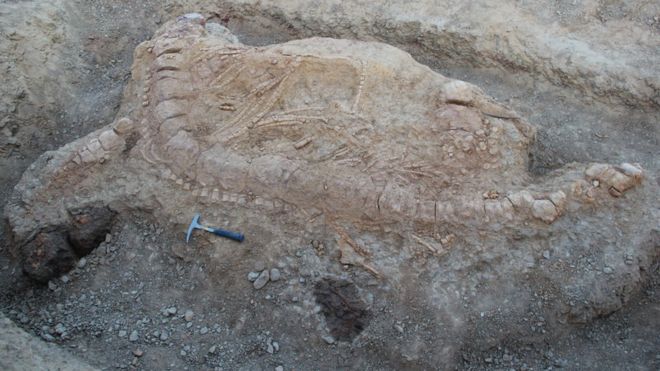@ WFS,World Fossil Society,Riffin T Sajeev,Russel T Sajeev
Scientists in India have discovered a 152 million-year-old fossil of an ichthyosaur – an extinct marine reptile – in the western state of Gujarat.
This is the first time an ichthyosaur fossil has been discovered in India.The fossil was found inside rocks from the Mesozoic Era, which ran between 252 and 66 million years ago, in the Kutch desert.
Prof Guntupalli VR Prasad, who led the study, said the 5.5m (18ft) specimen was almost complete.
Only parts of the skull and tail bones were found to be missing.The findings have been published in the Plos One science journal.
“This is a remarkable discovery not only because it is the first Jurassic ichthyosaur record from India, but also it throws light on the evolution and diversity of ichthyosaurs in the Indo-Madagascan region and India’s biological connectivity with other continents in the Jurassic,” Mr Prasad said.
The team, which comprised scientists from India and Germany, believes the newly discovered specimen can be identified with Ophthalmosauridae, a family of ichthyosaurs that lived in the oceans between 165 and 90 million years ago.
- Often misidentified as “swimming dinosaurs”, they first appeared in the early Triassic period (251 million to 199 million years ago)
- The name means fish-lizard, although the creature has been classified as a reptile since the mid-19th Century
- Its length ranged from 1m to 14m – although the average length was 2m to 3m
- The creature was noted for its sharp, robust teeth.
- Ichthyosaurs became extinct around 90 million years ago.
Source: Encyclopaedia of Paleontology.
A statement from the team said the identification of the new specimen may further throw light on whether there was any marine connection between India and South America about 150 million years ago.
An examination of the teeth of the fossil suggests that it was a top-tier predator in its ecosystem, it added.
Source:BBC News
@ WFS,World Fossil Society,Riffin T Sajeev,Russel T Sajeev



 October 26th, 2017
October 26th, 2017  Riffin
Riffin 
 Posted in
Posted in  Tags:
Tags: 